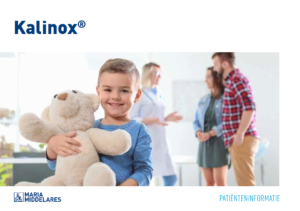Sedation with Kalinox® in children
What is it?
What is it?Sedation is artificially-reduced consciousness. The purpose of this sedation is for your child to be less aware of what is happening to him or her (e.g. testing, intervention, illness). The sedation is meant to reduce anxiety and the uncomfortable feeling that results. There many levels of sedation depending on how alert, cooperative, and awake the patient still is.
Kalinox® is the brand name of a gas mixture that is composed of 50% oxygen and 50% laughing gas. It is colourless and odourless. Laughing gas provides pain relief, reduces painful sensations and increases one's pain tolerance. In addition, it has a relaxing and slighly calming effect.
With sedation under Kalinox®, your son or daugher must breathe in the gas mixture a few minutes before the start of the procedure and until a bit after the procedure is finished. Your child remains awake the entire time and breathes independently. It is not necessary that your child be fasting.
What is the process?
What is the process?When we use Kalinox® to make a certain inervention less unpleasant, we work according to five steps. We let your child sit as long as possible on your lap to hopefully keep anxiety at a minimum.
- The first step is to fit your child with a mask that he or she will use to breathe in the gas mixture. This mask is a sort of cap that needs to fit snugly over the mouth and nose, without causing any painful pressure. Two lines are attached to the mask: one is to administer Kalinox® and one is for suctioning out the expired air. There is also a balloon on the mask. The balloon allows us to see if the Kalinox® gas mixture is circulating sufficiently.
- The second step is to place a pulse oximeter on your child's finger or toe. This is a special bandage or clasp with a little red light. We use it to monitor the heart rate and blood oxygenation.
- The third step is to start administering the gas mixture. Your child will continue sitting on your lap and breathing in through the mask, while you continue to hold your child. It takes about three to five minutes before your child is sufficiently relaxed.
- The fourth step is to carry out the actual intervention (wound cleaning, for example). It might be necessary for your child to leave your lap and to be placed on an examination or procedure table. It is during this phase that local anaesthesia is given with a needle, if additional local anaesthetic necessary. The Kalinox® is administered until the procedure has been completed.
- The fifth, and last step, is: your child will breathe in pure oxygen for another three minutes in order to 'wash away' any residual laughing gas remaining in the body.
What are the risks?
What are the risks?The chance of undesired effects is very small. Your child will stay awake the entire time and will be able to communicate. The possible side effects usually occur while the gas mixture is being used and disappear quickly after it is stopped. Possible reactions include: tingling, sleepiness, mood changes or perceptional changes (e.g. what we see or hear seems distorted), dizziness, nausea or vomiting.
Leaflet
LeafletSee the leaflet below for more information.
Only available in Dutch:

Sedatie met Kalinox
DownloadCentres and specialist areas
Centres and specialist areas
Something wrong or unclear on this page? Report it.
Latest publication date: 13/08/2024







